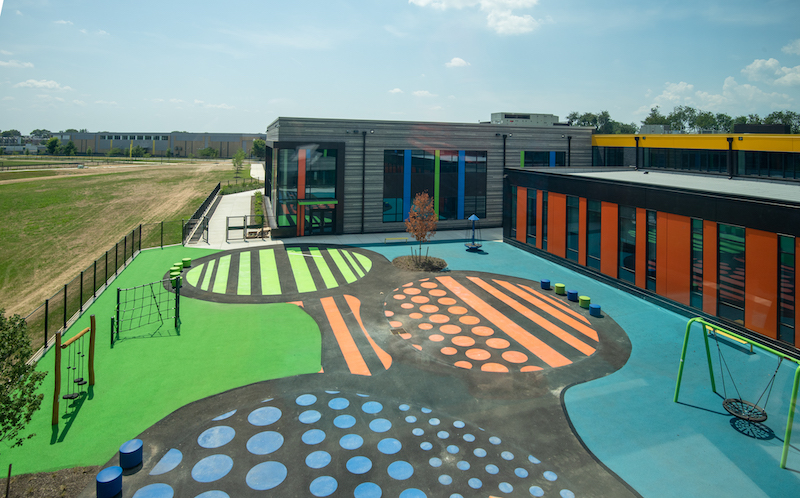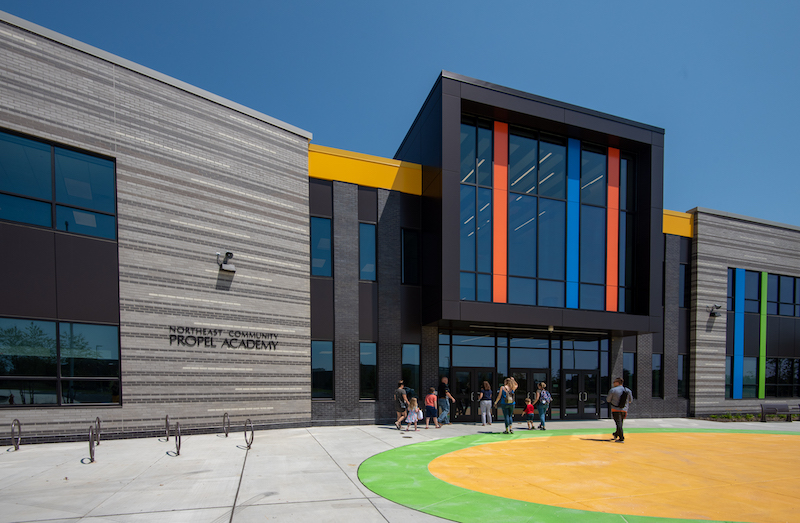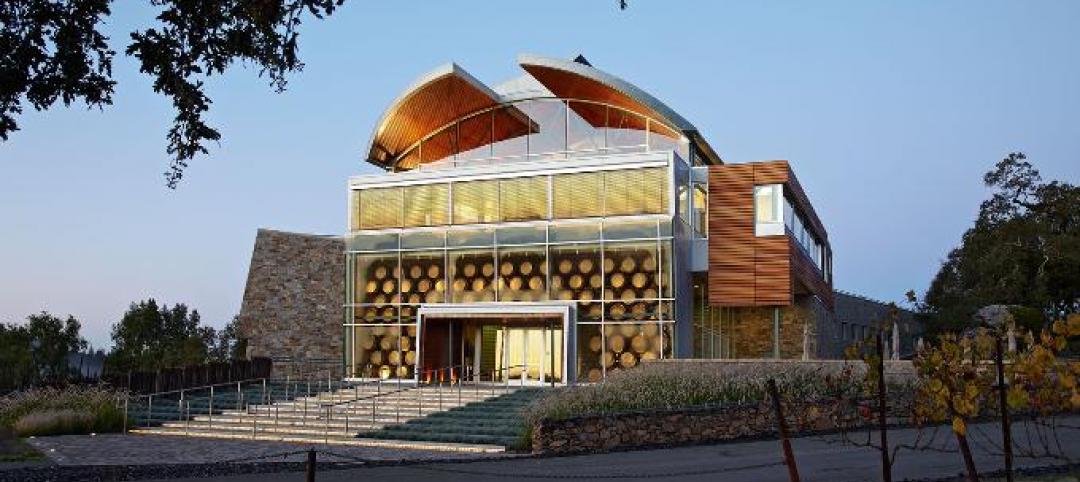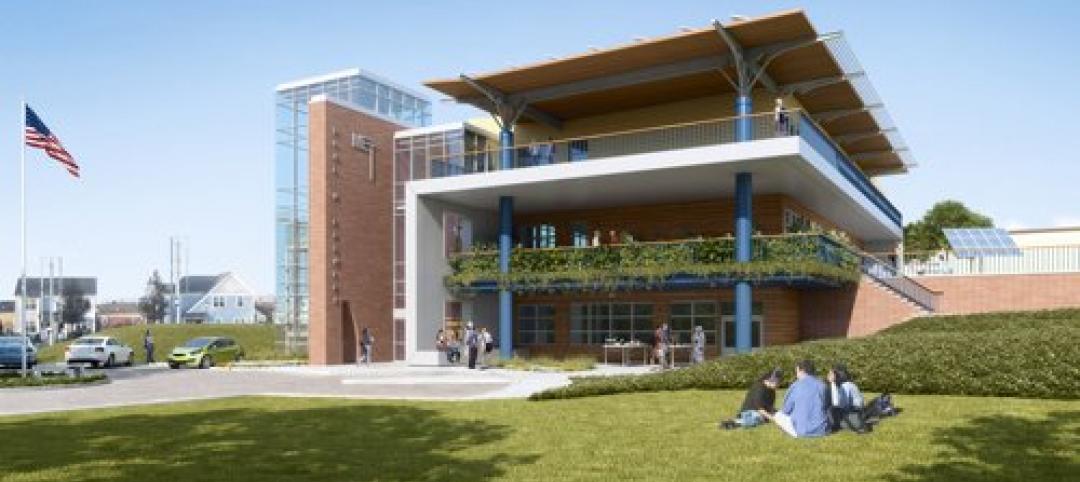Last Tuesday, the Northeast Community Propel Academy, a K-8 school with the capacity for 1,660 students, opened In Philadelphia. The 180,000-sf building was financed and constructed through a public-private partnership between the School District of Philadelphia and Gilbane Development Company, which provided turnkey development for the new school.
Gilbane Building Company acted as the project’s design-builder and hired Stantec as its architect. Gilbane was one of three firms that submitted bid proposals to the school district in the fall of 2017, and received the contract the following January, says Susan Tully, Senior Project Manager and Market Leader for Gilbane’s K-12 Center of Excellence. The school’s design was completed by October 2019, and after some municipal delays construction began in March 2020, “on the day the world stopped” because of the coronavirus pandemic, quipped Tully.
Propel Academy is in a multicultural section of Philadelphia that “is booming,” says Tully, with lots of service sector workers. But the number of school seats hadn’t kept pace with the community’s growth; Tully notes that another school there, built for 600 students, now serves 2,000. The district “knew they need to get a new school built quickly,” she recalls.
The school is on land that previously had served as baseball and softball fields. As part of the P3 agreement, Gilbane Development purchased the land from the school district for $1, and upon completion of construction on August 19, 2021 sold the property and school back to the school district for $79 million.
“Speed to market was a driver” for the P3 arrangement, says Luis Vildostegui, Stantec’s Senior Principal and Education Leader, whom BD+C interviewed with Jennifer Grafton, Stantec’s Project Manager and Senior Associate. Vildostegui notes that Propel Academy’s design reflects the school district’s gravitation toward a more socialized teaching model that focuses on learning with peers.
SCHOOL FEATURES COLLABORATIVE ZONES
Gilbane and Stantec, with Fengate Asset Management, were part of a construction financing consortium that in June broke ground on six K-12 schools in Prince George’s County, Md. This was the first P3 for schools in the nation, and it’s expected to cut in half the time it takes to complete those schools, which are scheduled to open in 2023.
In Philadelphia, the Propel Academy project “is one of the most collaborative I’ve worked on in my career,” says Tully. One of its advantages was Gilbane’s relationship with Stantec, which provided architecture, interior design, and civil engineering services. “We were able to advance the construction before the designs were completed, which fast-tracked the project,” says Grafton. And because Stantec had worked previously with the school district and Gilbane, “we could act as an intermediary” when decisions were made, says Vildostegui.
Stantec’s office in Philadelphia is right across the street from the school district’s, so it set up a big room where all of the project’s stakeholders could meet conveniently. “We were all there, resolving problems from the beginning,” says Vildostegui. Any additions or changes during the design or construction process had to be “cost-neutral solutions,” says Tully. (Nicole Ward, AIA, the school district’s design manager, was its liaison on this project.)
Those discussions included “challenging some basic assumptions,” says Vildostegui, like the building’s placement, which is adjacent to a park that exposures city kids to natural environments they might not see otherwise. During the permitting stage, the building team and school district also hashed out whether a retention basin on the site should be above or below ground (they ultimately chose the latter).
The building team’s early collaboration allowed its members to react quicker when there were materials shortages or delays. “We didn’t need to make compromises,” says Tully.

The Propel Academy was build on land that once served as ball fields, and is located near a tree-lined park.
A ‘SHINING SUCCESS STORY’ FOR P3s
Propel Academy is organized into clusters of classrooms and collaborative zones for small learning groups. There are six classrooms per grade for grades 1-5, and nine classrooms per grade for grades 6-8. The classrooms are positioned around shared media and tech commons within each grade level house, and the number of classrooms can be adjusted as needed.
The school also has science labs, music rooms, and “exploration” spaces, says Grafton. “It’s transformative,” says Vildostegui about the school’s design, that had to meet what Tully calls the school district’s “strict design standards” that are informed by LEED and WELL guidelines.
Tully sees Propel Academy as a “test case” for the school district, and believes P3 financial agreements will be more in vogue for financing school construction to meet clients’ demands for speed. “It’s a shining success story” for the P3 approach, adds Vildostegui. “It’s not for every project, but it’s quicker than a traditional design-bid-build because the issues get moved upfront.”
Related Stories
| Nov 15, 2013
Greenbuild 2013 Report - BD+C Exclusive
The BD+C editorial team brings you this special report on the latest green building trends across nine key market sectors.
| Nov 13, 2013
Installed capacity of geothermal heat pumps to grow by 150% by 2020, says study
The worldwide installed capacity of GHP systems will reach 127.4 gigawatts-thermal over the next seven years, growth of nearly 150%, according to a recent report from Navigant Research.
| Nov 5, 2013
Net-zero movement gaining traction in U.S. schools market
As more net-zero energy schools come online, school officials are asking: Is NZE a more logical approach for school districts than holistic green buildings?
| Oct 30, 2013
11 hot BIM/VDC topics for 2013
If you like to geek out on building information modeling and virtual design and construction, you should enjoy this overview of the top BIM/VDC topics.
| Oct 28, 2013
Urban growth doesn’t have to destroy nature—it can work with it
Our collective desire to live in cities has never been stronger. According to the World Health Organization, 60% of the world’s population will live in a city by 2030. As urban populations swell, what people demand from their cities is evolving.
| Oct 18, 2013
Researchers discover tension-fusing properties of metal
When a group of MIT researchers recently discovered that stress can cause metal alloy to fuse rather than break apart, they assumed it must be a mistake. It wasn't. The surprising finding could lead to self-healing materials that repair early damage before it has a chance to spread.
| Oct 15, 2013
15 great ideas from the Under 40 Leadership Summit – Vote for your favorite!
Sixty-five up-and-coming AEC stars presented their big ideas for solving pressing social, economic, technical, and cultural problems related to the built environment. Which one is your favorite?
| Oct 7, 2013
10 award-winning metal building projects
The FDNY Fireboat Firehouse in New York and the Cirrus Logic Building in Austin, Texas, are among nine projects named winners of the 2013 Chairman’s Award by the Metal Construction Association for outstanding design and construction.
| Oct 7, 2013
Geothermal system, energy-efficient elevator are key elements in first net-zero public high school in Rhode Island
The school will employ a geothermal system to heat and cool a portion of the building. Other energy-saving measures will include LED lighting, room occupancy sensors, and an energy-efficient elevator.
| Sep 24, 2013
8 grand green roofs (and walls)
A dramatic interior green wall at Drexel University and a massive, 4.4-acre vegetated roof at the Kauffman Performing Arts Center in Kansas City are among the projects honored in the 2013 Green Roof and Wall Awards of Excellence.

















